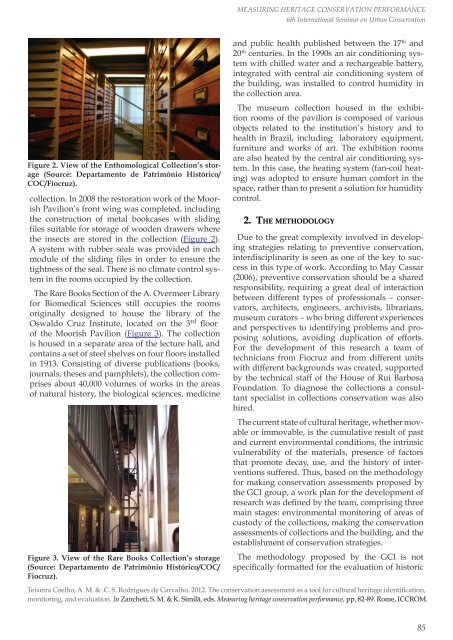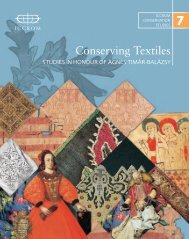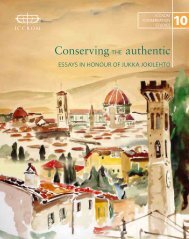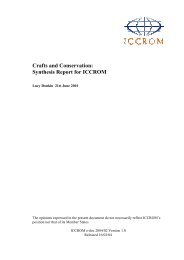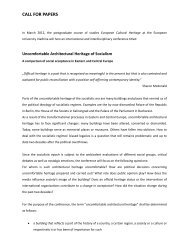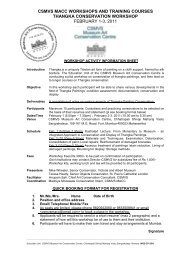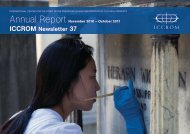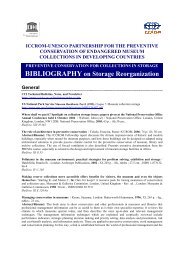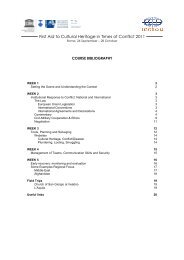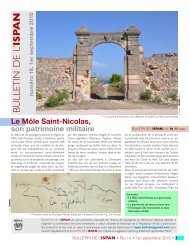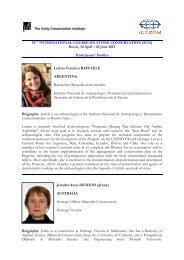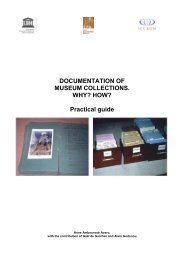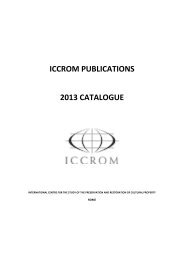part 1 - Iccrom
part 1 - Iccrom
part 1 - Iccrom
You also want an ePaper? Increase the reach of your titles
YUMPU automatically turns print PDFs into web optimized ePapers that Google loves.
MEASURING HERITAGE CONSERVATION PERFORMANCE<br />
6th International Seminar on Urban Conservation<br />
and public health published between the 17 th and<br />
20 th centuries. In the 1990s an air conditioning system<br />
with chilled water and a rechargeable battery,<br />
integrated with central air conditioning system of<br />
the building, was installed to control humidity in<br />
the collection area.<br />
Figure 2. View of the Enthomological Collection’s storage<br />
(Source: De<strong>part</strong>amento de Patrimônio Histórico/<br />
COC/Fiocruz).<br />
collection. In 2008 the restoration work of the Moorish<br />
Pavilion’s front wing was completed, including<br />
the construction of metal bookcases with sliding<br />
files suitable for storage of wooden drawers where<br />
the insects are stored in the collection (Figure 2).<br />
A system with rubber seals was provided in each<br />
module of the sliding files in order to ensure the<br />
tightness of the seal. There is no climate control system<br />
in the rooms occupied by the collection.<br />
The Rare Books Section of the A. Overmeer Library<br />
for Biomedical Sciences still occupies the rooms<br />
originally designed to house the library of the<br />
Oswaldo Cruz Institute, located on the 3 rd floor<br />
of the Moorish Pavilion (Figure 3). The collection<br />
is housed in a separate area of the lecture hall, and<br />
contains a set of steel shelves on four floors installed<br />
in 1913. Consisting of diverse publications (books,<br />
journals, theses and pamphlets), the collection comprises<br />
about 40,000 volumes of works in the areas<br />
of natural history, the biological sciences, medicine<br />
The museum collection housed in the exhibition<br />
rooms of the pavilion is composed of various<br />
objects related to the institution’s history and to<br />
health in Brazil, including laboratory equipment,<br />
furniture and works of art. The exhibition rooms<br />
are also heated by the central air conditioning system.<br />
In this case, the heating system (fan-coil heating)<br />
was adopted to ensure human comfort in the<br />
space, rather than to present a solution for humidity<br />
control.<br />
2. The methodology<br />
Due to the great complexity involved in developing<br />
strategies relating to preventive conservation,<br />
interdisciplinarity is seen as one of the key to success<br />
in this type of work. According to May Cassar<br />
(2006), preventive conservation should be a shared<br />
responsibility, requiring a great deal of interaction<br />
between different types of professionals – conservators,<br />
architects, engineers, archivists, librarians,<br />
museum curators – who bring different experiences<br />
and perspectives to identifying problems and proposing<br />
solutions, avoiding duplication of efforts.<br />
For the development of this research a team of<br />
technicians from Fiocruz and from different units<br />
with different backgrounds was created, supported<br />
by the technical staff of the House of Rui Barbosa<br />
Foundation. To diagnose the collections a consultant<br />
specialist in collections conservation was also<br />
hired.<br />
The current state of cultural heritage, whether movable<br />
or immovable, is the cumulative result of past<br />
and current environmental conditions, the intrinsic<br />
vulnerability of the materials, presence of factors<br />
that promote decay, use, and the history of interventions<br />
suffered. Thus, based on the methodology<br />
for making conservation assessments proposed by<br />
the GCI group, a work plan for the development of<br />
research was defined by the team, comprising three<br />
main stages: environmental monitoring of areas of<br />
custody of the collections, making the conservation<br />
assessments of collections and the building, and the<br />
establishment of conservation strategies.<br />
Figure 3. View of the Rare Books Collection’s storage<br />
(Source: De<strong>part</strong>amento de Patrimônio Histórico/COC/<br />
Fiocruz).<br />
The methodology proposed by the GCI is not<br />
specifically formatted for the evaluation of historic<br />
Teixeira Coelho, A. M. & .C. S. Rodrigues de Carvalho. 2012. The conservation assessment as a tool for cultural heritage identification,<br />
monitoring, and evaluation. In Zancheti, S. M. & K. Similä, eds. Measuring heritage conservation performance, pp. 82-89. Rome, ICCROM.<br />
85


